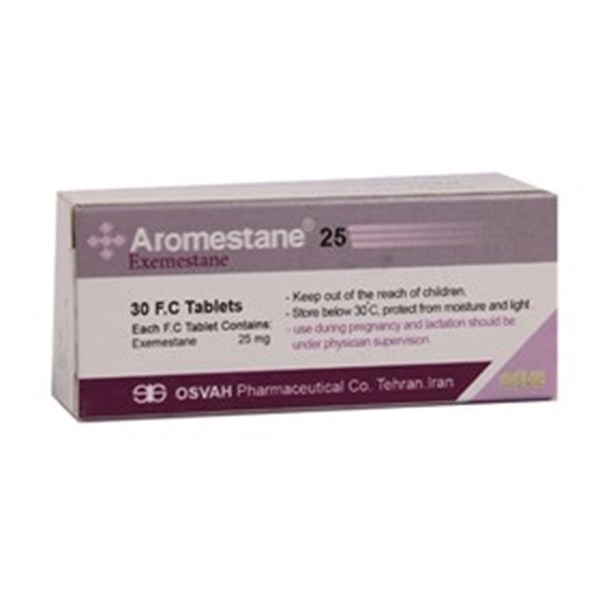Category:
Irreversible aromatase inhibitor / Antineoplastic Agent
Pharmacokinetics:
Absorption
Following oral administration of radiolabeled exemestane, at least 42% of radioactivity was absorbed from the gastrointestinal tract. Exemestane plasma levels increased by approximately 40% after a high-fat breakfast.
Distribution
Exemestane is distributed extensively into tissues. Exemestane is 90% bound to plasma proteins and the fraction bound is independent of the total concentration. Albumin and α1-acid glycoprotein both contribute to the binding. The distribution of exemestane and its metabolites into blood cells is negligible.
Metabolism and Excretion
The cumulative amounts of exemestane excreted in urine and feces were similar (42 ± 3% in urine and 42 ± 6% in feces over a 1-week collection period). The amount of drug excreted unchanged in urine was less than 1% of the dose. Exemestane is extensively metabolized, with levels of the unchanged drug in plasma accounting for less than 10% of the total radioactivity. The initial steps in the metabolism of exemestane are oxidation of the methylene group in position 6 and reduction of the 17-keto group with subsequent formation of many secondary metabolites. Each metabolite accounts only for a limited amount of drug-related material. The metabolites are inactive or inhibit aromatase with decreased potency compared with the parent drug. One metabolite may have androgenic activity. Cytochrome P-450 3A4 (CYP 3A4) is the principal isoenzyme involved in the oxidation of exemestane.
Mechanism of action:
Breast cancer cell growth may be estrogen-dependent. Aromatase is the principal enzyme that converts androgens to estrogens both in pre- and postmenopausal women. While the main source of estrogen (primarily estradiol) is the ovary in premenopausal women, the principal source of circulating estrogens in postmenopausal women is from conversion of adrenal and ovarian androgens (androstenedione and testosterone) to estrogens (estrone and estradiol) by the aromatase enzyme in peripheral tissues. Estrogen deprivation through aromatase inhibition is an effective and selective treatment for some postmenopausal patients with hormone-dependent breast cancer.
Exemestane is an irreversible, steroidal aromatase inactivator, structurally related to the natural substrate androstenedione. It acts as a false substrate for the aromatase enzyme, and is processed to an intermediate that binds irreversibly to the active site of the enzyme causing its inactivation, an effect also known as “suicide inhibition.” Exemestane significantly lowers circulating estrogen concentrations in postmenopausal women, but has no detectable effect on adrenal biosynthesis of corticosteroids or aldosterone. Exemestane has no effect on other enzymes involved in the steroidogenic pathway up to a concentration at least 600 times higher than that inhibiting the aromatase enzyme.
Indications:
-adjuvant treatment of postmenopausal women with estrogenreceptor positive early breast cancer who have received two to three years of tamoxifen and are switched to Aromestane for completion of a total of five consecutive years of adjuvant hormonal therapy.
-treatment of advanced breast cancer in postmenopausal women whose disease has progressed following tamoxifen therapy.
Administration and Dosage:
The recommended dose of Aromestane in early and advanced breast cancer is one 25 mg tablet once daily after a meal.
In postmenopausal women with early breast cancer who have been treated with 2–3 years of tamoxifen, treatment with Aromestane should continue in the absence of recurrence or contralateral breast cancer until completion of five years of adjuvant endocrine therapy.
For patients with advanced breast cancer, treatment with Aromestane should continue until tumor progression is evident.
Contraindications:
Aromestane tablets are contraindicated in patients with a known hypersensitivity to the drug or to any of the excipients.
Precautions:
• Aromestane tablets should not be administered to premenopausal women.
• Aromestane should not be coadministered with estrogen-containing agents as these could interfere with its pharmacologic action.
• For patients receiving Aromestane with a potent CYP 3A4 inducer such as rifampicin or phenytoin, the recommended dose of Aromestane is 50 mg once daily
• The safety of chronic dosing in patients with moderate or severe hepatic or renal impairment has not been studied. Based on experience with exemestane at repeated doses up to 200 mg daily that demonstrated a moderate increase in non-life threatening adverse events, dosage adjustment does not appear to be necessary.
Pregnancy and breast feeding:
Pregnancy: Category D
Lactation: There are no studies in pregnant women using Aromestane. Aromestane is indicated for postmenopausal women. If there is exposure to Aromestane during pregnancy, the patient should be apprised of the potential hazard to the fetus and potential risk for loss of the pregnancy.
Side effects:
The most frequently reported adverse effects for exemestane are gastrointestinal disturbances, hot flushes, arthralgia, myalgia, sweating, fatigue, and dizziness. Other reported effects include headache, insomnia, somnolence, depression, skin rashes, alopecia, asthenia, and peripheral and leg oedema. Thrombocytopenia and leucopenia have been reported occasionally. Reductions in bone mineral density can occur with long-term use of exemestane.
Drug Interactions:
• The metabolism of exemestane is mediated by the cytochrome P450 isoenzyme CYP3A4. Rifampicin, a potent inducer of CYP isoenzymes, can decrease plasma concentrations of exemestane. Use with other drugs that induce this isoenzyme may reduce the efficacy of exemestane. Exemestane should also be used cautiously with drugs that are substrates for CYP3A4 and that have a narrow therapeutic index.
• Significant effects on exemestane clearance by cytochrome P450 isoenzyme inhibitors are considered unlikely. Exemestane should not be given with oestrogen-containing drugs as these would negate its pharmacological action.
Packaging:
Aromestane is available as 25 mg F.C tablets in box of 30 tablets.
Storage:
• Store below 30 °C
• Protect from moisture and light
• Keep out of the reach of children


